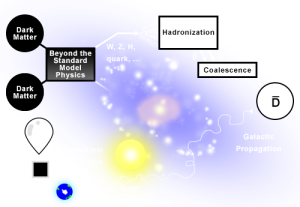The General Antiparticle Spectrometer (GAPS) is the first experiment optimized to detect cosmic-ray antinuclei below 0.25 GeV/n as a signature of dark matter annihilation or decay in the Galaxy. Compared to other experimental handles for detecting dark matter, antideuterons provide a uniquely precise target: the expected astrophysical antideuteron background is orders of magnitude lower than the possible dark matter signal, such that a single antideuteron at this energy scale would be a smoking-gun signature of new physics. The GAPS program will also provide a precision antiproton spectrum in a previously unprobed low-energy range, as well as leading sensitivity to antihelium-3 nuclei.
The GAPS scientific program is accessible thanks to a novel particle identification method based on exotic atom formation, de-excitation, and decay. Exotic atoms provide a unique handle for the negatively-charged antinuclei, facilitating excellent rejection of the positive-nucleus background. Meanwhile the method does not require a magnet, enabling a large sensitive area for rare events. With its large acceptance and orthogonal sources of systematic uncertainty compared to other experiments, GAPS will either make the first definitive detection of a cosmic-ray antideuteron or exclude the diverse dark matter models that would produce these particles.
